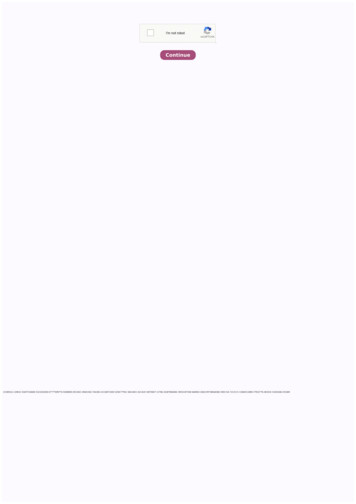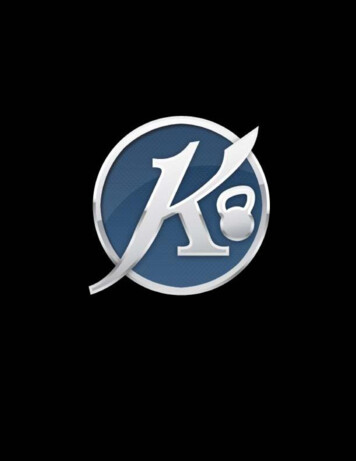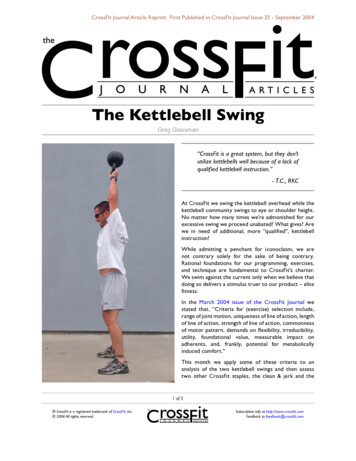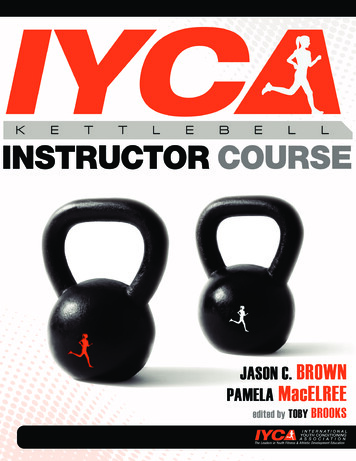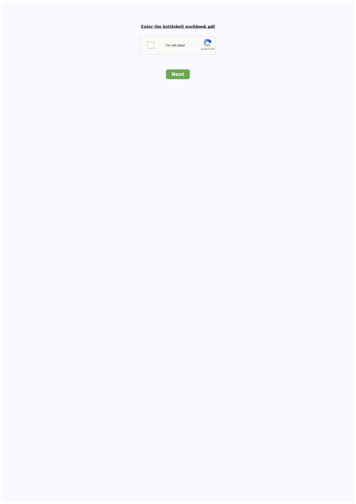
Transcription
Enter the kettlebell workbook pdfNext
Enter the kettlebell workbook pdf
Anthony diluglio enter the kettlebell workbook pdf. Aos enter the kettlebell workbook pdf. Enter the kettlebell workbook pdf. Anthony diluglio enter the kettlebell workbook. Art of strength enter the kettlebell workbook pdf.Do you see a bug? Give us! Here you can also share your thoughts and ideas about LiveJournal updates your request has been presented. You can follow the progress of your request in: If you have any other questions or comment, you can add them to that request at any time. Send another report Close Comments Community documents FindCommunity resource documents to facilitate municipal administration, public works, recreation and well-being, environmental services, protection services, community development, territorial planning, community planning and infrastructure development. Profiles of the Community Census of Manitoba Find Data from the 2016 census, such aspopulation, workforce, income and income and other statistics of the communities of Manitoba. List of communities in Manitoba Find descriptions of communities in Manitoba such as geography, culture, climate, health services from various cities, towns and villages. Municipal contact information Find contact information such as your municipalelected representatives, evaluation district and its community planning and planning districts. Regional Health Administration of Manitoba. Offices of the Department of Social Services of Manitoba. Housing offices of Manitoba throughout Manitoba. Provincial Departments Departments of the Government of Manitoba, corona companies, joints andorganisms. All deaths in France since 1970 (Source: Data.gouv.fr / Insee) Hopes of life are calculations based on data from deaths, this is and will remain an estimate. A Politologue.com site- All data all come from public data available in OpenData â "Ã, 0.00, â " â "Ã, e-BookÃ, » redirects here. For other meanings, see E-Book (homonymy).Digital bookDiferants appliances (portable phone, reader, tactical tablet) that they use Applications for reading digital booksType Digital fileManufactureManufacturer Digital publishersUseUse ReadingEdit â modify the code â modify Wikidata The digital book (in English: ebook or e-book), also known as e-book and notebook, is an e-book and e-book.electronic book. Edited and disseminated digitally, available as files, which can be downloaded and stored for playback on a screen[1],[2] (personal computer, mobile phone, reader, tablet), on a Braille band, an audiobook reader or a browser. History Detailed article: Gutenberg Project#History. 1970s and 1980s In 1971, Michael Hart created theGutenberg project with the aim of digitizing a large number of books and creating a virtual library with a collection of freely accessible electronic documents[3]. With this project, Hart wanted to initiate new practices of diffusion (and, eventually, of reading) other than paper. Published on July 4, the national holiday of the United States, theDeclaration of Independence of the United States was the first electronic document of Project Gutenberg (5 KB file) [4]. Due to limited access to the Internet, the project is progressing slowly. However, since the 1980s, the community has benefited from regular access to the Internet, and the rate of growth of publications has accelerated. In 1989, thetenth anniversary of the project was commemorated with the online publication of the book King James Bible[5]. At the same time, in 1978, the Canada Council for the Arts created Canadiana, a non-profit organization dedicated to preserving Canada’s heritage and putting it online. In 1986, the Franklin company launched the first dictionary, “whichcan be consulted on a pocket machine”.[5] Years 1990 During the last decade of the 20th century, new initiatives were launched. Shape in the Universe of the Digital Book: In 1990, Eastgate Systems publishes one of the first examples of hypertextual literature, in the afternoon, a history of the Michael Joyce crivacy [6] in 1993, John Mark OckerbloomCreder online book page. Unlike the Gutenberg project, this project seeks to the repository and merge English-speaking numbers published differently, within a single access point. In 1994, the Gutenberg project highlighted its arithmetic century, with the realization of William Shakespeare [7]. In 1995, Jeff Bezos Crà mazon.com, the first largeelectronic library in the United States. Amazon.com will then know a quick success; Which is today the prize of the digital booksellers [5]. The same year, in Montrà , Pierre Gagnon Français [8] founded on Diel, a first platform of electronic publishing. The press, in its broadest sense, continues to be online. In 1996, Olivier Gainon founded Cylibris,the first French-speaking digital home of roots that publishes digital books and is printed on the web [5]. From home, Brewster Khale founds Internet archive. In 1997, the National Library of France created Gallica. In 1998 he founded 0:00, a house entirely dedicated to digital books [5]. Announcement of the years 2000 in 2000, the Mobipocketreading software is created. This software “is specified in reading and distribution secured with pounds for personal assistant [5] to.” The Gemstar eBook becomes the first official digital reading tablet after buying the two competitors .: NuvoMedia and Soft Press Book [9]. In 2001, Adobe Flash Player released its first free software that allows you toplay digital files. The same year goes back to the concept of a French-speaking novel by mail, which consists in publishing, one chapter at the same time, a novel by electronic mail [5]. In addition, a first tablet of launched in Europe; This is Cybook. The year 2001 finally marks the creation of the first smartphone. In 2004, Sony Company produced itsown tablet. According to Marie Lebert, this release of Sony marks the declinations of the popularization of digital stage tablets (or “readers”) [5]. The same year, Google launched Google Books, which allows you to read books online, consult with methods (date of publication, author (s), editor, page (s) consulted ((s), etc.) and carry out Research onthe body of the text [5]. In 2005, Open Content Alliance is jointly created by the Internet Archive and Yahoo, to allow the reading of all texts available on all search engines [5]. In 2007, Amazon sells Amazon Kindle, or Kindle, allowing the company to specify in digital playback, while focusing even on paper. In 2008 Publicado.NET was created, thefirst collaboration of authors for the digital transmission of Litthat Contemporary. Publie.net pushes EPUB3 resources until it adds sound, music, and videos [10] over the course of the system, and â Hyperimages Navigation System (currently only available on iPad and iPhone). The same year, the Big Ten Academic Alliance found Hathitrust and theEuropean Commission launched EuropeanA. As of 2008, the quality of reading on the screen of readers is considering considerably. Combined with other factors (including internet access equipment), these improvements provide the numerical progression of US book market shares in 2010 [11]. Many publishers are beginning to distribute, inelectronic format, books that fall into the public domain. At the same time, for a CO-TS and cost-effective question, some publishers start publishing their in this way. Therefore, some authors who wish to free themselves from the restrictions imposed by the editors [12], or whose manuscripts have never been published, choose from the beginning thedigital self-publishing to make available to the public (s) free works or not ( Payment download sites). Designations The Expression â «Digital Book» and its synonyms «Electronic Book» and «Book Libreâ» have been proposed by the Quebec Office of the French language [2] (OQLF) as translations to the France of the Tà English terms  «ã, e-bookÃâ»,  «Ã, Electronic BookÃ,» or  «, Digital Bookà ,.» According to the OQLF, the hybrid form of «Electronic book» (Layer of English  «Electronic book») must be avoided [2]. In France, the denominations «Digital Book» was officially recommended in the JORM on April 4, 2012 [1]. In current use [where?], The terms «electronic book» and «freebook» designate both the content (the text) and by metonymia, the content (the support that allows the content to be visualized ). These two expressions are, therefore, also synonyms of «Read» [2]. However, this use is erroneous since, as it indicates its definition, the digital book is a digital file and not the electronic device that allows to consult it. Ifthe content and container are often confused, you do not have to confuse the digital book with its format (Epub, Mobipocket, etc.). Types of digital books Fabrice Marcoux highlights three main types of digital books: homothel, enriched and  «Originally digital» [13]. Homothic It is the «IDTIC Transposition of a book printed on digital version [14].»The homothetical digital book respects the physical limitations of the book despite the absence of these limitations in a digital environment. This is the extended form and the To appear. Enriched. This type of book comes to complete the printed version of the benefits that the number format allows for both the form and the content. In particular, wethink of hyperlinks and inserting other media (images, voids, sounds). Therefore, because of the almost endless possibilities of enrichment of the work it admits, the enriched type is increasingly exploited. Going in the same way, Nolwenn TrÃ Æ ONDART defines this type of digital books as adopting intermediate forms that “look at those of the printedbook, adding visual and hypertextual enrichment. [15]. Name the example of the enriched numbered book, the Horla, designed by the Chamber of Education to be appreciated in 2015. During a step, for example, while the narrator criticizes the people who launched by the government debt in Paris on July 14. , the reader is called to touch points ofcolor that overlap on the texts and simulate the explosion of fireworks. In another passage, the text becomes blurred and duplicates the image of the disorder experienced by the character who fears going crazy and losing control of his perceptions [15]. “Originally numbered.” Marcoux wrote that this is the book “created by or for the numerical”, i.e.that the book was originally thought to be numerical. Depending on the numerical format and its technical potentialities. For this reason, it has a strong hypertextuality, but it is more recent and less common than the preferential ones. In this case, it is also possible to speak of an increase in [16]. The scalar platform is a platform that allows theediting of book increases. It was designed in 2009 by the Alliance for Visual Culture Networks. Thanks to the creation of hyperlinks, the literary course of the work can be modified according to the interests of the reader [16]. of a digital book Marin Dacos and Pierre Mounier identified three qualities of a digital book: its readability, manageability andcitability[17]. Its legibility. The e-book must be legible. This means: that it is described in an open format (as opposed to proprietary formats); that it is fluid and reflowable; that it is permanent. Its manageability. The e-book must be manipulable. To do this, it is necessary to index its content and perform searches. The more application books wecreate, the harder it is to index them and create indexing tools. The text must also be copied and pasted, so that it can be quickly inserted into another context (copy-paste procedure). Finally, the text should also be able to be written (notations, comments, milestones, etc.) on open devices. Your subpoenament. The book should be quoted and done ina simple way. Digital leads to solutions based on the logic of a unique identifier (ID). Several devices have been developed implemented in different environments and based on different logics. In the publishing world, the ISBN has been used for books and the ISSN for periodicals since 1970 and 1975, respectively. These unique identifiers describeeditorial objects, i.e. a work title or a newspaper title. The ISBN corresponds to an important level of granularity since it is the complete book that is identified. Interests and Risks This section does not sufficiently cite your sources (November 2018).To improve it, add verifiable references [How do I do it?] or the {{Reference required}}} template topassages that require a source. Interests Physical Maniability and Physical Technique: The “complete” written work of Victor Hugo edited by Jean-Jacques Pauvert 40 million characters. The Bible, so that we can fall into the Internet, has less than 10 million bytes, regardless of the language considered [18] (about 9.5 MB). Therefore, a simple 32 GBSDHC card allows you to carry around 2,000 collections of texts of this size anywhere. Technique: a given passage of a book, when you know a specific word, is quickly done even if the document has no indexes. Text can be annotated and recordable (notations, comments, milestones, etc.) on open devices. Reader independence: You can view a digitalbook on several reading devices (reader, computer, tablet, smartphone, Braille beach, audio book reader, etc.). In some cases, if we are connected to the Internet, we find the exact passage where we stopped while consulting a work, even from another medium. Accessibility Practical and commercial practice: in comparison with the classic form that isthe printed book, this digital book for people with disabilities, the advantage of better accessibility. In fact, the digital book can be restored on a suitable device, on the Braille screen, for example, or on a sound reset. There are numbers of numbers intended for a limited audience. In particular, the case of the daisy, the standard of audiobooksintended specifically for a public incapable of reading printed documents (blind, visually impaired, dyslexic, person with a situation of physical disability, etc.). It is also necessary to mention the frog format created to make reading easier for DYS. Commercial: In recent years, the Eargent countries have experienced strong growth in digital books,particularly in India [19]. According to a study conducted in 2011, 18 '% of Indians and 24'% of Blanders have downloaded a digital book, and these numbers are constantly increasing[20]. In 2011, the Argentine philosopher and editor Octavio Kulesz[21] conducted a study entitled Digital publishing in developing countries. According to this study, thedigital book is a real asset for the development of emerging countries at the educational and economic levels. Kulesz argues that countries like India, Brazil and China have to take the pin out of the game to appropriate Western new technologies. For example, to combat illiteracy, India had marketed a reader at an uncompetitive price. Risks RichardStallman, an American Free Software activist, identified a number of dangers associated with the digital book, among them: since you have to identify yourself to pay online or download a book from a commercial website or a digital library, they “authorize” Internet users. They can access their playlist; that there are several precedents for “remotedeletion of books by at least one distributor (Amazon.com) on the devices of people who have bought them[22]. Stallman points out, however, that the works of Project Gutenberg and some other digitization initiatives do not present such risks. As with all digital files, especially those that users store on an external (cloud) server, the question is whatwould happen to your library if an editor (or distributor, or even a digital storage service provider) went missing? Formats Logo of the EPUB format. When publishing a digital book, the publisher must choose between several types of formats, which can be open or closed, free (text file, HyperText Markup Language, EPUB, Extensible MarkupLanguage, TeX, ODT, FictionBook, etc.) or proprietary. Document Format, DOCX, Rich Text Format, PostScript, AZW, etc.). According to Viviane Boulereau and Benoit Hatert, this option is not neutral [23] à “à ” Choosing a format has profound implications: the information that can be transmitted change, as well as its readability, its universality,its arrangement Portability, transformability, etc”.[24]. Rights management copyright management At the time when the digital book starts to grow, some are opposed to copyright conflicts. Therefore, Google’s first attempts around digital publishing of printed books have experienced large parts due to this type of conflict [5]. In response to theseissues, the Creative Commons Licence, conceived by Lawrence Lessig, was issued in 2001, which allows digital publishing that protects copyright [5]. In France, some associations that act in the service of persons with disabilities with the exception of copyright under the law of Dadgsi. For these structures, there are two levels of aggression [25]: thesimple grace that grants the right to adapt the works and communicate them to people with disabilities, on the one hand, and the authorization to request access to the digital archives of the National Library of France (BNF) invested with this mission by the Decree. of 6 February 2009 [26], on the other hand. Article DE: Copyright and NeighboringRights in the Information Society # Chapter I – Exceptions to Rights D Author and Neighboring Rights. Digital Rights Management As in the fields of music and films, some publishers and distributors use Digital Rights Management (DRM) systems to try to protect works. Most of these systems are relatively inefficient and paint more readers thancounterfeit users [27], DRMs have been removed or at least disagree. Certain DRM referral table [28] Efficient name formats used by Adept reviews Adobe Epub, PDF, ASCM Srainstite, Kobo, B & N, Sony, Google DRM standard is often used. Requires an account on the Abobe site and limits the legibility of a six-camera book. Microsoft Microsoft BedMicrosoft Kepub (Adept) Kobo (Adobe) Kepub Kobo Works for an epub with some more data. The files can be tested in EPUB DRM Adobe Standard. Amazon Azw Topaz, TPZ Amazon New Amazon Format, based on your favorite mobipocket format. MobiPocket Amazon Mobi Amazon (Old) Format created by MobiPocket (purchased from Amazon). Itworks with a PID system (one key per hardware). IgnOBLE (based on adepte) B & N (Adobe) B & N Adobe DRM Extension where it uses the name CB and the number as a key (to deter participation). ERERADER B & N PDB, PML B & N (Old), PALM OLD B & N format, which also uses the name and CB number as a key to share the social brake.Fairplay Apple Apple is used on iBooks. The files are only read by Apple devices, with no bug searches to date. BBEB Sony LRX, LRS Sony abandoned LCP LCP EPUB TEA (PocketBook) implemented in the Sub-Format Attention created by the Reading Consortium, the protection against lightweight content (LCP) is an open format (OpenSource)provides flexibility of implementation and transparency of use for the reader. Some e-books do not contain a digital rights management system, but digital tattoos, usually the name of the buyer and their e-mail address. Finally, many open works (because they fall into the public domain) are available for free download from many websites, includingthe Gutenberg project, from the Open Library [29], o Feedbooks/publicdomain[31]. Some publishers oppose these brands and offer their books DRM-free. By the year 2020, more than 200 publishers have opted for this option.[32] Logo of the publishers' movement against DRM Reception of the public While the first e-books appeared, many readershave had a retreat from the possibilities offered by this new technology. [ref. Even the pioneer Michael Hart would have doubted the success of Project Gutenberg. “We consider electronic text as a new medium, with no real relationship to paper. The only point in common is that we spread the same works, but I don’t see how paper can compete withelectronic text once people are used to it, especially in “teaching” institutions.[33] The habit issue therefore appears to be paramount at the time of the appearance on the market of the first digital books; readers are not yet conditioned to this new reading format. Although the content remains the same, this “does not mean that the digital bookshould be trivialized; in fact, the latter differs from its acolyte on paper and thus calls for a redefinition of its production stages”.[34] By the same concepts of hypertext and hyperlinks that it involves, the digital book modifies the modes of reading that were accepted by paper. The breadth of content that a book may request (especially if it is enrichedor “originally digital”) may prove to the reader if it is poorly integrated. Therefore, the e-book must meet certain conditions to ensure its “good” reception[35][insufficient source]: Usage metaphor. In order to avoid discouragement in the face of too many references, links, images, etc., the booklet present your content to the reader in such a way thatthe reader can easily see what is being presented to him and get an idea of what lies ahead. Uniform elements of interaction. The aim is to enable the reader to find a logic in their interaction with the documents placed at their disposal by an e-book. For this reason, playback apps often offer different options to facilitate navigation between contents.Reusing a more conventional paratext (cover, index or table of contents, etc.) digitally is often a good way to increase the reader’s confidence[36]. This is in part the logic behind the recovery of physical fitness by the homothetic book. Participation of the reader. Private databases are often made available to the reader so that he can make his ownannotations, additions, highlight important passages, etc. In this way, you can “customize” the e-book, appropriate it, or increase your reading process without imposing your modifications on others. Reception is also intrinsically linked to readers' limited access to the Internet network. If the creation of the web in the 1990s[5] allowed the first boomof the digital book among specialized specics [For example?], the second boom did not come until a decade later, with the generalization of the web and the improvement of the quality of the products. Detailed article: List of digital publishing houses. Market situation in France The first e-book distributor in France to date is Mobipocket.com (asubsidiary of Amazon since April 2005[37]). However, there are other platforms where it is possible to obtain digital books, such as Vivlio, Numilog.com (a subsidiary of Hachette Livre since spring 2008[38]), ePagine (a provider of solutions for bookstores), immaterial.fr and reseller), relay.com (also a subsidiary of Hachette, but on the presses side),Eden Books, E-Platform, Youscribe, Scribd, Youuboox, iBooks, Cyberlibris (Subscription Digital Library), Needocs (Professional Books, Practical and academics) and also didactibook (electronic bookcase specialized in practical books). According to Challenges magazine, the FNAC sold 40,000 digital books between November 2008 and November 2009[39]. In 2011, the manufacturer of Bookeen readers took place at the marketing of digital books with Bookestore.com [40]. The offer of digital books in Francà s Rica of the market is offered by CH Chapter.com [41]. According to the fourth barometro on the uses of the digital book, submitted on March 21, 2014 at the Paris Book Room, it isestimated that the fee of digital readers in France is 15.,% of the population [42]. Among the respondents, 39% [43] think that the use of electronic books will increase, which is verified in the March 2016 edition [44], since the quota of readers reached 20Ã,% of the respondents . Today in France, although users of electronic books think that the usesare still going to evolve; There are still many that combine electronic reading with paper books. In 2018, the turnover of the electronic book exceeds the barrier of 100 million euros for the first time. The offer of digital books increases, but with a 3.5,% of market share uses evolve slowly [45]. In the United States at the last quarter of 2010,Amazon.com officially announced that he had sold more digital books for printed books [46]. The most popular galls are then the romances and erotic romances [47], [48]. In the first quarter of 2012, sales of digital books exceeded sales of printed books in the country [49]. According to the Pew Internet & American Life Project, Americans read atleast one digital book in 2013 [50]. According to the same institute, in January 2014, 50Ã,% of Americans had a digital tablet or a reader. Sales of digital books were reduced by 10.% between 2016 and 2017, according to a study conducted by digital pubtrack. In 2016, the digital book represented 21st,% of sales, to descend to 19th,% in 2018 [51]. Inthe United Kingdom in 2009, in the United Kingdom, the digital book represents 2,% of market shares, and then grows up to 6 to 11%. In 2010, the Bloomsbury editor announces that the sale of digital books corresponds to the 10th,% of its sales in the United Kingdom. With regard to Pregío Penguin, the digital book represents the 8th,% of its sales,in 2011 [52]. In 2016, in the United Kingdom, the digital book represents the 35th,% of the total billing of the member publishers of the publishers' association, with 1,700 million pounds [53]. In Canada Quebec Since December 2009, the Development Society of Cultural Companies (SODEC) offers a program of «aid to the digitalization thatreimburses publishers 50% of digitization expenses, more 10, By title, up to a maximum of 5, 000, , what could help these last to offer a greater portion of its catalog [54]. However, despite these efforts, and even for books available since its launch in digital format, digital book sales accounted for only 1.1% of book sales in Quebec in 2014, whilearound 80Ã, % of the books put on sale that year were available. In digital format [55]. This represents around 506,000 digital books. However, it is not a full portrait, since sales made through some online libraries such as Apple and Amazon are excluded from the calculation. Only sales made in Quebeous Digital Warehouses [56] are taken intoaccount. In 2017, 16% of Quebequenses el el digital books or journals according to the statistics presented by CEFRIO. This represents a decrease of 3% compared to the previous year. The activity is more popular among university graduates[57]. English Canada In English Canada, the situation is different. According to 2017 figures, digital booksales accounted for 18.6% of total book sales.[56] Costs related to the digital book While the cost of the PDF printer (homothetic representation of the printed work) is absorbed by the usual costs of producing paper, the same is not true for the rest.[58] Two types of costs should be foreseen: production costs. In a digitization (scanning), the differentcosts involve the costs of scanning, recomposing (typewriting enrichment), proofreading and correcting, the costs of structuring an Epub format (it is essential to integrate the metadata, whether it be the cover, the title, the ISBN, etc.) summary, etc.). For a “habitual” novel (large format, 256 pages), a study by MOTif (the observatory for books andwriting on the island of France) estimated, in 2010, the costs at around 1,199 [58]. If it is a publication without digitization (scanning), the costs are lower: the costs associated with digitization are saved and the costs of proofreading are limited (less risk of error associated). For the same type of novel, the expenses are estimated at 665à  [58],almost double the cost. The costs of distributing the e-book differ from those of the printed book. First of all, the introduction of marking fees (DRM or Watermarking), which make it possible to control the circulation of the book and significantly prevent piracy. The cost of a DRM brand in 2010 was 0.40 per copy[58], which is often inaccessible tosmall and medium-sized companies. companions. The watermark, or digital tattoo, is a free solution for this editor. Then, in addition, the diffusion layers: the digital books are actually sold through many channels (digital offer in some booksellers, excellent cultural and cigar players like Amazon, Kobo or Numilog). Publishers often entrust the uploadand storage of their files to a broadcaster â that claims a percentage on every sale. The digital editor, otherwise, meets the costs of computing, archiving and maintenance to postpone your publications on a virtual storage site “. In addition, are the various promotional and marketing costs; As part of the reasoning study, several groceries consideredthat these tariffs corresponded to 3 or 4% of the selling price, although these cooperations varied significantly from one publisher to another [58]. Finally, bank charges would resume between 3 and 6% of the selling price. However, these coins are taken over by booksellers or sales portals, and not by EDivers. Notes and References â ’A and B TheFrench Republic “, a vocabulary of the publishing and the book (List of terms, expressions and definitions adopted) à , No. 0081, in Legifrance.gouv.fr, Official Journal of the French Republic, April 4, 2012 (accessed on 21 December 2012). February 2017), p. 6130. â “ ABC and D “Digital Book”, the Grand Dictionary of Terminology, Office Quà echof the French Language (accessed January 20, 2019). â “ Marie Lebert, “A Brief History of the Electronic Book” [PDF], in studies-Francaises.net, French Girls of the University of Toronto, 2009 (Consult 21 2017 February 2017: à “Tone often passed quietly, Michael Hart is the true inventor of the electronic book. If we consider the e-book in itslogical sense, namely, a digital book number for the dissemination of fi
Anthony diluglio enter the kettlebell workbook. Art of strength enter the kettlebell workbook pdf. Do you see a bug? Give us! Here you can also share your thoughts and ideas about LiveJournal updates your request has been presented. You can follow the progress of your request in: If you have any other questions or comment, you can add them to .
